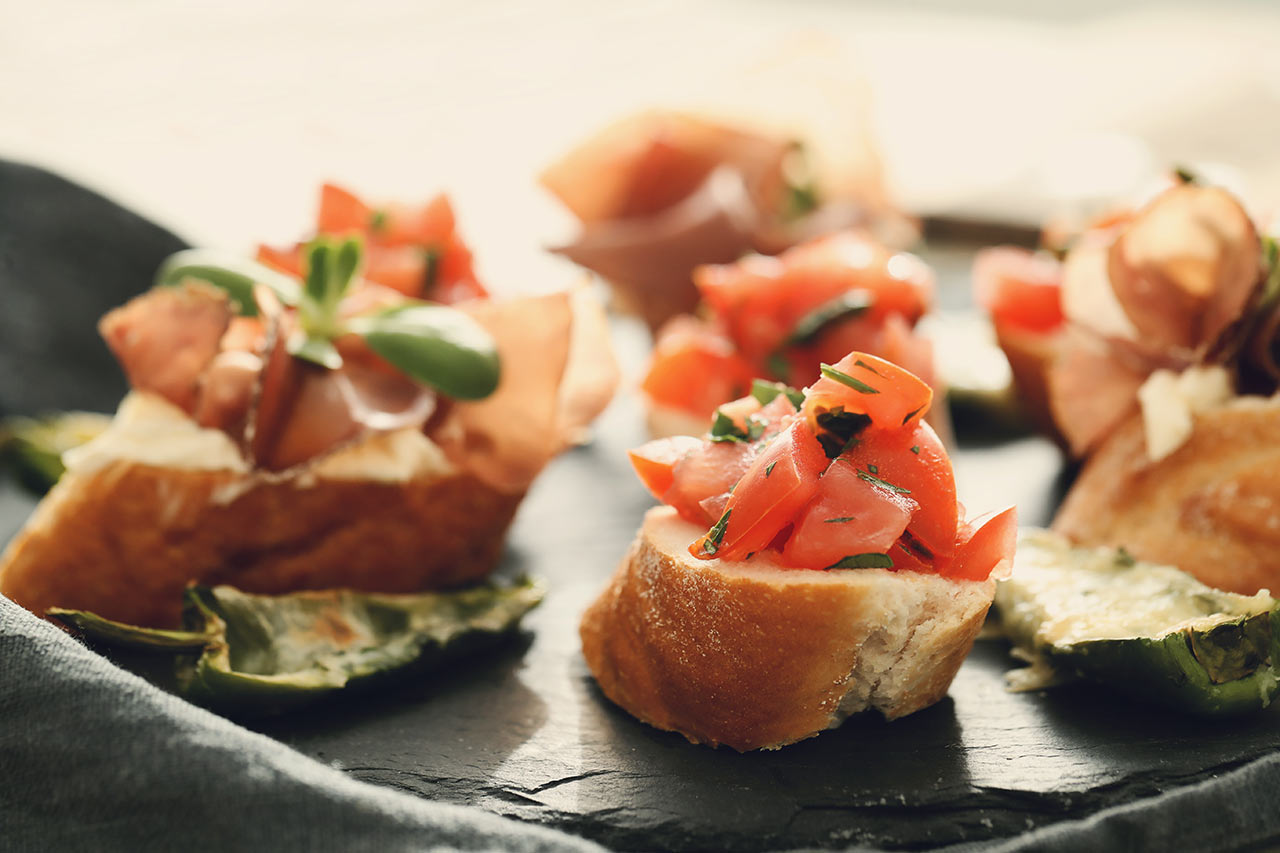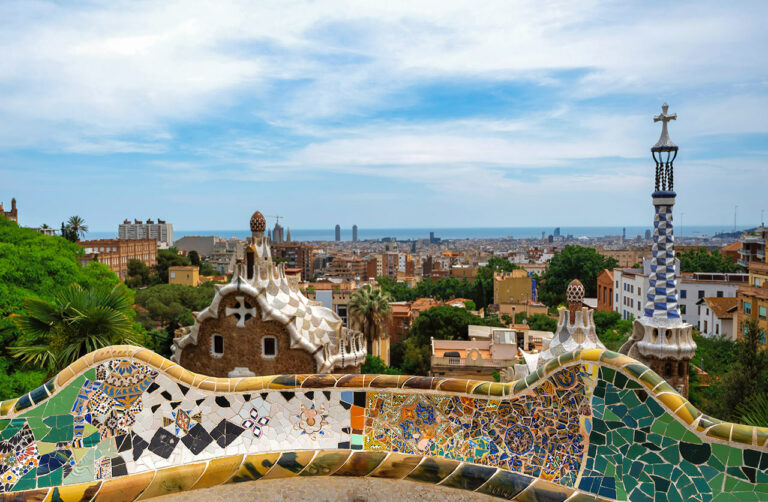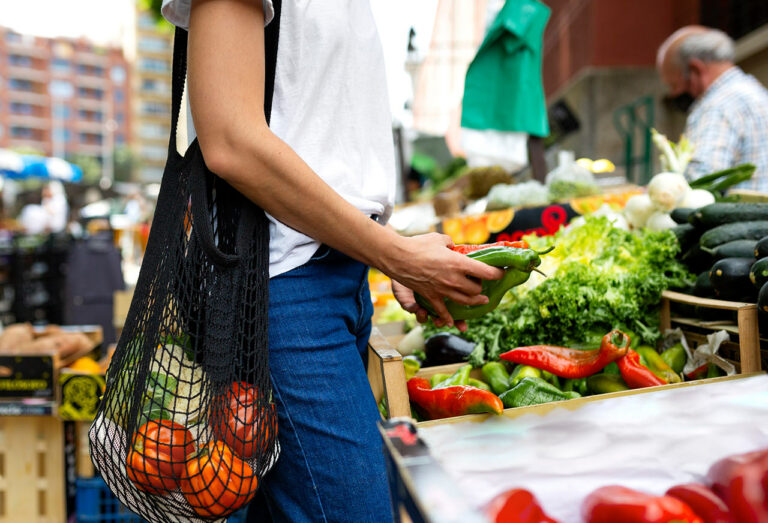Famous Foods Of Barcelona (A Guide To Barcelona Food Culture)
Barcelona has a rich culinary landscape that’s full of unique flavors, local ingredients, and traditional recipes. When you’re in the city, you’ll get a taste of the traditional Catalan cuisine, which is considered a Mediterranean cuisine due to its variety and the use of fresh ingredients.
Beyond the tantalizing tapas and savory seafood paellas, Barcelona’s food culture is a tapestry of history, geography, and identity. Its streets hum with bustling markets, where locals haggle for the freshest produce and age-old taverns that have witnessed the ebb and flow of the city’s gastronomic evolution. Each bite in Barcelona tells a story, from the mountainous influences of the Pyrenees to the breezy Mediterranean shores. Diving into the city’s culinary scene is more than just indulging in good food; it’s experiencing centuries of traditions, influences, and passion on a plate.
Barcelona Food Culture
The food culture in Barcelona is all about freshness and quality. Local markets like La Boqueria offer a wide array of fresh produce, seafood, and other culinary delights that represent the city’s culinary DNA. This vibrant market culture is essential to the local cuisine, as chefs and home cooks alike rely on these fresh ingredients for their daily cooking.
One more thing that makes Barcelona’s culinary scene stand out is its tapas culture. A tapas crawl in the city will give you the chance to sample various small dishes that make up a major part of Spanish cuisine, which allows you to taste multiple flavors in one sitting. From traditional tapas like patatas bravas and pimientos de padrón to modern variations, there’s no shortage of delightful nibbles all around the city.
In a nutshell, your tastebuds are in for a treat when you visit Barcelona. Get ready to embark on a culinary adventure filled with fantastic flavors and unforgettable experiences.
Influences and Evolution
The city’s cuisine has been shaped by various influences, including Spanish, Mediterranean, French, and Italian culinary traditions. This fusion of flavors has led to the evolution of the diverse and delectable dishes that you can enjoy today.
Catalonian cuisine has a strong Mediterranean influence, which is evident in its use of ingredients like olive oil, tomatoes, and garlic. Fresh seafood from the coast and locally grown produce are also key components of their dishes. You’ll find a love for nuts, wild mushrooms, and a variety of beans in many traditional meals, emphasizing the region’s bountiful resources.
Besides the Mediterranean identity, French and Italian influences have also played a significant role in shaping Barcelona’s food culture. The close proximity to the French border and historical ties to Italy have contributed to the integration of numerous elements from these culinary cultures into Catalonian dishes. Don’t be surprised to find variations of pasta, risotto, and even the use of béchamel sauce in some local creations.
Barcelona’s food scene has managed to strike a balance between traditional and modern, respecting its culinary roots while embracing innovation. This delightful mix can be seen in the selection of meats used in Catalan dishes, such as:
- Botifarra negra: pork blood sausage.
- Botifarra blanca: white pork sausage.
- Botifarra d’ou: white pork sausage with egg.
- Fuet: a long thin sausage of dried cured pork meat wrapped in the gut, resembling salami.
So, as you explore Barcelona’s vibrant food scene, take note of the diverse influences and the history hidden in every dish. Savor the unique blend of flavors that combine Spanish, Mediterranean, French, and Italian influences, creating an unforgettable culinary experience that truly captures the essence of this remarkable city.
Signature Dishes
Barcelona is a food lover’s paradise, and its cuisine reflects the rich Catalan culture. The city is brimming with amazing signature dishes that you won’t want to miss. Let’s dive into some of the classic Catalan delicacies that you must try on your trip to Barcelona.
Paella and tapas are undoubtedly two of the most renowned Spanish dishes. In Barcelona, though, you’ll also want to indulge in fideuà, a paella variant made with noodles instead of rice. The dish gets its unique texture from this slight twist, and you can often find it at the best paella restaurants in town.
Another must-try is calçots, a type of green onion grilled to perfection and typically served with romesco sauce. This delightful dish is celebrated every year during the Calçotada festival, where locals gather to enjoy and share this Catalan delicacy with friends and family.
For an authentic taste of Catalan comfort food, try escudella i carn d’olla, a hearty meat and vegetable stew often served during colder months. A bite of pa amb tomàquet (bread rubbed with ripe tomatoes, olive oil, and salt) alongside this dish takes the experience to another level.
While exploring the city, don’t miss out on the bustling tapas bars renowned for their mouth-watering dishes such as bombas (potato croquettes filled with ground meat, usually served with spicy tomato sauce) and patatas bravas (fried potatoes in a spicy bravas sauce). For a slightly different tapas experience, head to a pintxos bar. Here, you’ll find an array of small, tasty bites served on a slice of bread and held together with a toothpick.
A classic Spanish dish that you simply must try is tortilla de patatas, a thick and hearty potato omelette often served in pie-like wedges. Another Catalan favorite is canelons, pasta tubes filled with minced meat, topped with béchamel sauce, and baked until golden and bubbling.
For more traditional Catalan fare, dig into a plate of botifarra amb mongetes (pork sausage with white beans) or savor a serving of mandonguilles amb sípia (meatballs with cuttlefish). And don’t pass up the chance to sample sopa de galets, a classic holiday soup featuring large pasta shells and a rich meat broth.
Experience the harmonious marriage of sweet and savory in dishes like espinacs amb panses i pinyons (spinach with raisins and pine nuts) and escalivada (a salad of roasted eggplant, bell peppers, tomatoes, and onion). If you’re feeling a bit adventurous, the uniquely flavorful cargols a la llauna (grilled snails) are worth a try. And when you’re in need of a quick, satisfying snack on the go, look no further than the humble but delicious bocadillo, a Spanish sandwich served on a crusty baguette.
In the Barcelona food scene, you can’t miss out on some of the popular local dishes that showcase the true essence of Catalan cuisine. Here are some of the must-try dishes while you’re exploring this amazing city:
- Pa amb tomàquet: A simple yet flavorful dish of bread rubbed with ripe tomatoes and drizzled with olive oil, sometimes topped with cured ham or cheese.
- Faves a la Catalana: These Catalan-style broad beans are slow-cooked with rich sofrito (a sauce made of onions, tomatoes, and garlic) and pieces of Spanish sausage.
- Botifarra amb mongetes: This iconic combination of grilled Catalan sausage and white beans will leave you craving for more.
- Calçots: Grilled spring onions dipped in a romesco sauce, typically served during calçotada festivals from late winter to early spring.
- Espinacs amb panses i pinyons: Spinach dish cooked with raisins and pine nuts, featuring a delicate balance of sweet and savory flavors.
Star Ingredients in Barcelona’s Catalan Food
Let’s have a look at some of the star ingredients that make the local Catalan cuisine so fabulous.
Seafood plays a crucial role due to Barcelona’s location along the Mediterranean coast. You’ll find a variety of shellfish and fish dishes like cod, anchovies, and fresh seafood mixed in with rice, like in the well-known paella dish.
Rice is another important player. Barcelona serves up some splendid rice dishes, such as the classic arroz negro – a striking black squid ink rice dish often topped with cuttlefish.
Bread really shines in Barcelona’s culinary scene. Head to any tapas bar, and you’ll find delicious pan con tomate – a local specialty tomato bread made with ripe tomatoes, garlic, and drizzled olive oil.
Speaking of tomatoes, Barcelona cuisine showcases an array of local produce like fresh tomatoes, eggplant, peppers, artichokes, spinach, and seasonal mushrooms. These ingredients often steal the show in traditional Catalan dishes.
Oil and Salt are essential in any Barcelona kitchen. With a myriad of flavors, extra virgin olive oil is often used for cooking or drizzling over dishes. Salt is used to enhance the taste of fresh ingredients and comes in various forms like sea salt or the famous local salt flakes.
Hearty cheeses and quality ham will elevate your taste buds. From Jabugo ham platters to unique cheese varieties, these cold cuts are iconic among locals and visitors alike.
The humble onion plays an essential role in traditional Catalan dishes like the calçots. These sweet and tender spring onions are grilled and served with Romesco sauce.
The captivating aroma of garlic perfumes Catalan cuisine, adding a whole new layer of flavor to dishes like sofregit, a slow-cooked sofrito of onions, tomatoes, and garlic.
Pairs like chicken and chocolate or spinach and pine nuts showcase the diversity and creativity of Barcelona’s food culture. Enjoy exotic dishes like lobster with chocolate or relish the sweetness of cinnamon in typical desserts.
Barcelona treats food as an art, combining fresh produce, seafood, and flavors to create an unforgettable culinary experience. Don’t be afraid to indulge yourself and let the star ingredients of Catalan cuisine tantalize your taste buds.
Emblematic Sausages and Meats
When it comes to Catalan cuisine, the variety of outstanding options goes hand in hand with meat lovers’ cravings. Some of the top choices include jamón, chorizo, and botifarra amb mongetes.
Jamón Ibérico and Serrano are top-quality hams that you simply cannot miss. Jamón Ibérico, also known as Iberico ham, is made from a unique breed of pig, fed on a diet of acorns. This results in a rich, marbled meat with a distinct flavor. On the other hand, Jamón Serrano is a cured ham with a mild, slightly salty taste. Both are essential additions to your Barcelona culinary experience.
Now, let’s talk chorizo – a spicy sausage made from pork seasoned with smoked paprika. Not only is it a popular dish in Catalan cuisine, but you can find it all over Spain. You’ll often find it served cold as a tapa or incorporated into various recipes, like paella.
Time for some botifarra amb mongetes! This traditional Catalan dish consists of grilled botifarra sausage paired with sautéed white beans. It’s a staple in many of the best local restaurants and is sure to satisfy any meat lover looking for authentic Catalan flavors.
Sweet Treats and Desserts
When exploring Barcelona’s vibrant food scene, you’ll quickly notice a vast array of tempting sweets and desserts. If you have a sweet tooth, you’re in luck! In this beautiful city, you can indulge in some traditional Catalan delights that will have you craving more.
Crema Catalana is one of the all-time favorites you should try. Often compared to crème brûlée, this classic Catalan dessert has a rich, custard-like base with a crispy caramelized sugar top. It’s a must-try when in town. Feel free to impress your friends with your newfound knowledge of this tasty treat.
If you’re a fan of chocolate, Barcelona has your back. The city is home to some exceptional chocolate shops, offering unique creations that’ll make you feel like you’ve entered chocolate heaven. But don’t forget to also try some Spanish-style hot chocolate, paired with churros. Sounds mouth-watering, right? This iconic pairing is a delight for both locals and travelers..
Moving on, another traditional dessert worth checking out is Mel i Mató. It’s a simple yet delicious combination of fresh mató cheese topped with honey. This dessert’s humble ingredients let the natural flavors shine, giving you a taste of true Catalan culture.
Apart from these well-loved treats, Barcelona’s bakeries and markets offer a plethora of other sweets to fulfill your cravings. Keep an eye out for treats like Catànies, Neules, and Panellets, all of which hold a special place in the hearts, and stomachs, of the locals.
Beverage Culture
When visiting Barcelona, be ready to experience a rich beverage culture that’ll keep your thirst quenched throughout your trip. The city offers a wide range of drinks, from wines to sangria, vermouth, and more. So, let’s dive into some of the most popular drinks you’ll find in this Catalan capital.
Sangria is a must-try drink when in Barcelona. This refreshing blend of red wine, chopped fruit, and a touch of brandy is a Spanish classic. You’ll find it on the menu at almost every tapas bar, and it’s the perfect accompaniment to your meal. However, be aware that the quality can vary, so do some research and find the best spots in town for a genuinely delightful sangria experience.
Wine is a staple in Spanish culture, and Barcelona is no exception. As you might expect, Catalan wines hold a special place in the hearts of locals. The region offers a variety of wines, such as red, white, and rosé. In particular, Catalan white wines are gaining popularity, as they are fresh and crisp, ideal for warm, sunny days. Give them a try, and you won’t be disappointed!
One spirited Catalan beverage you’ll want to taste is cava. It’s Catalonia’s answer to champagne, and 95% of cava production occurs in the nearby Penedès region. Pop open a bottle of this sparkling wine, available in white or rosé, to toast your time in Barcelona. You can find cava at many local bars and restaurants, but seek out places like Can Paixano, a popular spot for both locals and tourists.
Vermouth is another beloved drink in Barcelona, and it has recently made a major comeback. Often served over ice with a slice of orange or a green olive, it’s a popular choice for a pre-dinner aperitif. Vermouth bars, or vermuterías, can be found throughout the city, so don’t miss out on the chance to experience this renaissance firsthand.
Sampling Barcelona
Here’s your personal guide to where and how to sample some of the best culinary delights this city has to offer.
Tapas bars are a must when you’re in Barcelona. These small plates, ranging from simple olives to gourmet bites and seafood, are served in bars and restaurants throughout the city. Whether you’re strolling through the bustling La Boqueria market or wandering the narrow streets of the Gothic Quarter, you’ll find an abundance of spots to enjoy these quintessential Spanish treats. Take your time and hop between tapas bars, tasting a variety of dishes paired with a glass of local wine or beer.
In addition to tapas, Barcelona’s food scene is bursting with fresh seafood and Catalan specialties. For a true taste of the city’s gastronomy, consider joining a food tour. These guided excursions typically lead you through neighborhoods like Sant Antoni and Poble Sec, with stops at carefully-selected markets, food shops, and restaurants. They provide a unique way to experience Barcelona’s culinary heritage and discover hidden gems, all while learning about the city’s history and culture.
Speaking of markets, La Boqueria is a must-visit destination for any food lover. This iconic market located off La Rambla is a sensory feast, overflowing with fresh produce, seafood, meats, cheeses, and more. Remember to sample some traditional dishes while you’re there, like Esqueixada de Bacallà (a salted codfish salad) or the hearty stewed oxtail, Cua de Bou. Be sure to also pick up some snacks to bring back to your Airbnb or hotel – trust me, you won’t regret it!
For a more local and less touristy experience, head to the Sant Antoni neighborhood, home to an up-and-coming food scene. Here you’ll find the recently renovated Mercat de Sant Antoni, where locals shop for groceries and indulge in delicious bites. Still hungry? Swing by Poble Sec to soak up its energetic vibe and explore the numerous eateries, bars, and restaurants lining its streets.
Basically, wherever you go in Barcelona, your tastebuds are bound to be satiated, and the city’s tapas culture makes it easy to eat a small bite or two at every stop along the way.







